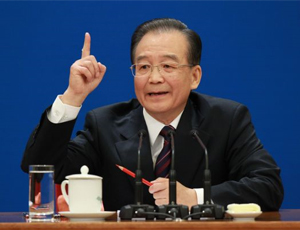NPC and 12th Five Year Plan – China’s Leaders Pass the Buck
Problems not addressed as leaders look forward to retirement
Op-Ed Commentary: Chris Devonshire-Ellis
 Mar. 15 – As the delegates at China’s National People’s Congress drift away, as I predicted, it was an overall case of more of the same. This year’s NPC, at which the next five-year-plan is discussed and approved, has more resonance than others. Much of the current leadership is set to retire within the next 12 months – everyone from Chairman Hu Jintao, Premier Wen Jiabao and the nation’s keeper of purse strings, Liu Minkang, are all set to don slippers and embrace a more sedentary life.
Mar. 15 – As the delegates at China’s National People’s Congress drift away, as I predicted, it was an overall case of more of the same. This year’s NPC, at which the next five-year-plan is discussed and approved, has more resonance than others. Much of the current leadership is set to retire within the next 12 months – everyone from Chairman Hu Jintao, Premier Wen Jiabao and the nation’s keeper of purse strings, Liu Minkang, are all set to don slippers and embrace a more sedentary life.
What is needed, according to them, is more of the same. No real concrete measures were adopted other than a fairly lame recognition that China’s growth would slow. Yet what many in China believe is required is a fairly urgent need for reform and much assertive leadership in key areas. If that is true, this NPC did not deliver. The buck is being passed to the next generation – yet handcuffing them to a plan they have to adhere to but may not agree with. I wrote about this back in October, when the plan was first being discussed, in my article China’s Plenum on Five Year Plan – Actually More of the Same.
It’s a no-brainer in terms of growth – China has been shouting about its GDP rates for years now. Usually above 10 percent or more, there’s no real shock in that given the bonanza that China’s admission into the WTO has given it. What is now a US$3.3 billion economy was just a third of that size in 2001. Given a relatively low base to start with, the rise of China as a global economy and that 10 percent growth rate is no surprise. What is also unsurprising is the fact that it is beginning to slow – it’s hard to maintain annual base growth rates from an ever increasing economy. So, we are told China will grow at 7 percent from now on. That’s it?
That’s news however for many of China’s provincial and city governments, well used to being asked to maintain rates at 10 percent or higher. China’s second tier leaders on the ground as it were have to follow the government policy – and the temptation to influence actual growth rates through a variety of “get growth fast” schemes has become endemic. Some cities have already made plans to expand their economies by 30 percent, as we pointed out back in January.
The quickest way to get that growth into official statistics is through property development, and I still don’t get the lack of analytical attention to this. Traveling extensively throughout China every year I notice increasing amounts of empty blocks of apartments, industrial parks and even entire cities. Sitting on the government books as assets to show off to the NPC as “growth,” they are actually nothing of the sort. China, in fact, has huge volumes of white elephants to clear out of its system. It’s dangerous to make individual comparisons when comparing specific projects with the might of China’s economy, however I do believe in this case they are symptomatic of a wider malaise. Guangzhou’s spanking new opera house, for example, is only showing two actual operas this year. The building is there, but the soft part – administration costs and operating it effectively – seems to be missing. Still in Guangzhou, the city’s recent Asian Games cost an estimated US$18 billion – which is more than London is spending in next year’s Olympics. The gigantic and hugely impressive new airport in Northeast China’s Manzhouli is capable of handling five million passengers a year. But the city’s population is about 125,000.
Not all of the buildings are sound either. In what ex-Premier Zhu Rongji used to term “tofu constructions,” a little reported 5.8 magnitude earthquake in Yunnan last week destroyed close to 2,000 houses and badly damaged another 49,000. Some 300,000 have been made homeless following the quake in the county of Yingjiang, near China’s border with Burma. According to Wang Yayong, a chief engineer at the Chinese Academy of Building Research, “the buildings should not have fallen like that.” GDP growth targets meet shoddy construction. Local media report that 25 people died and a further 250 were seriously injured in the disaster suppressed by the horrific news coming out of Japan. But it doesn’t disguise the national malaise of growth targets being married to property developers; it’s merely just another example in an increasingly long list of subverted developments.
It’s these on-going cases that are starting to make analysts question what is really going on. Chinese banks fueled record property-price gains by extending a record US$2.7 trillion in loans over 2009 and 2010 under the stimulus program that propelled the nation through the Global Financial Crisis. Regulators’ efforts to contain the risks for lenders have included stress tests for declines in housing prices and a crackdown on lending to local government financing vehicles. However, the much respected Fitch Ratings report earlier this month targets exactly the sector I see as troublesome – those property developments. Stating the risk of “holes in bank balance sheets” should a property bubble burst, Fitch suggested that China faces a 60 percent risk of a banking crisis by mid-2013 in the aftermath of these record lending and surging property prices. At the NPC, the Chinese banking regulator shrugged off such suggestions and indicated bad debt levels would be about 3 percent. But it’s also not going to be his problem. He’s due for retirement and won’t want any tail end bad news at the end of his watch. My suspicions then are that the issues are being pushed under the carpet.
Apart from bad debt in the banking system, China somewhat incredibly, actually has a housing problem. The types of buildings actually being built tend to be luxury developments (got to get that GDP growth rate onto the balance sheet) and are beyond the affordability of many. There aren’t enough low-medium priced residential areas being built. When advised by a respected China economist that “migrant workers” staying closer to home would live in them, two issues came to mind: at current levels, how are they going to afford them, and secondly, if prices drop significantly to the level they can be affordable, presumably the local governments and property developers are going to have to take a haircut – as well as the banks who extended the loans. For me, the perfect circle of GDP growth and property development as a focal point for it seems not to have been well formed after all. That lack of affordable housing too creates problems – frustrations over not being able to buy a decent house, and the cries of outrage from those citizens who did buy and move into negative equity.
This is the fourth five year plan that I have witnessed take shape during my time in China, and it’s the first time I’ve felt the country was treading water with no clear objectives in solving its problems. The race to GDP growth has yet to be proven wise, and leaders seem more obsessed with seeing out a glorious career rather than dealing with today’s problems now. The buck is being passed, and the new government to be introduced in March 2012 is going to face an uphill battle to deal with a five year plan that leaves them with no mechanisms to cope with any problems. With no apparent road map to equip them with exit signs for getting off a road that is starting to look increasingly ill-advised, the new leaders in 12 month’s time may well have just been handed a poisoned chalice.
Related Reading
 China Briefing May 2007 – Annual Ministerial Briefings
China Briefing May 2007 – Annual Ministerial Briefings
A walk back down memory lane in this 2007 issue of China Briefing, and the then NCP meeting discussing the 11th Five-Year-Plan that has just been completed. (Complimentary download)
China Bears Gather as Analysts Question the Economy
- Previous Article Coastal China, Inland China, India or Vietnam for Your Sourcing Business?
- Next Article China-India Weekly Business Update: March 15




























